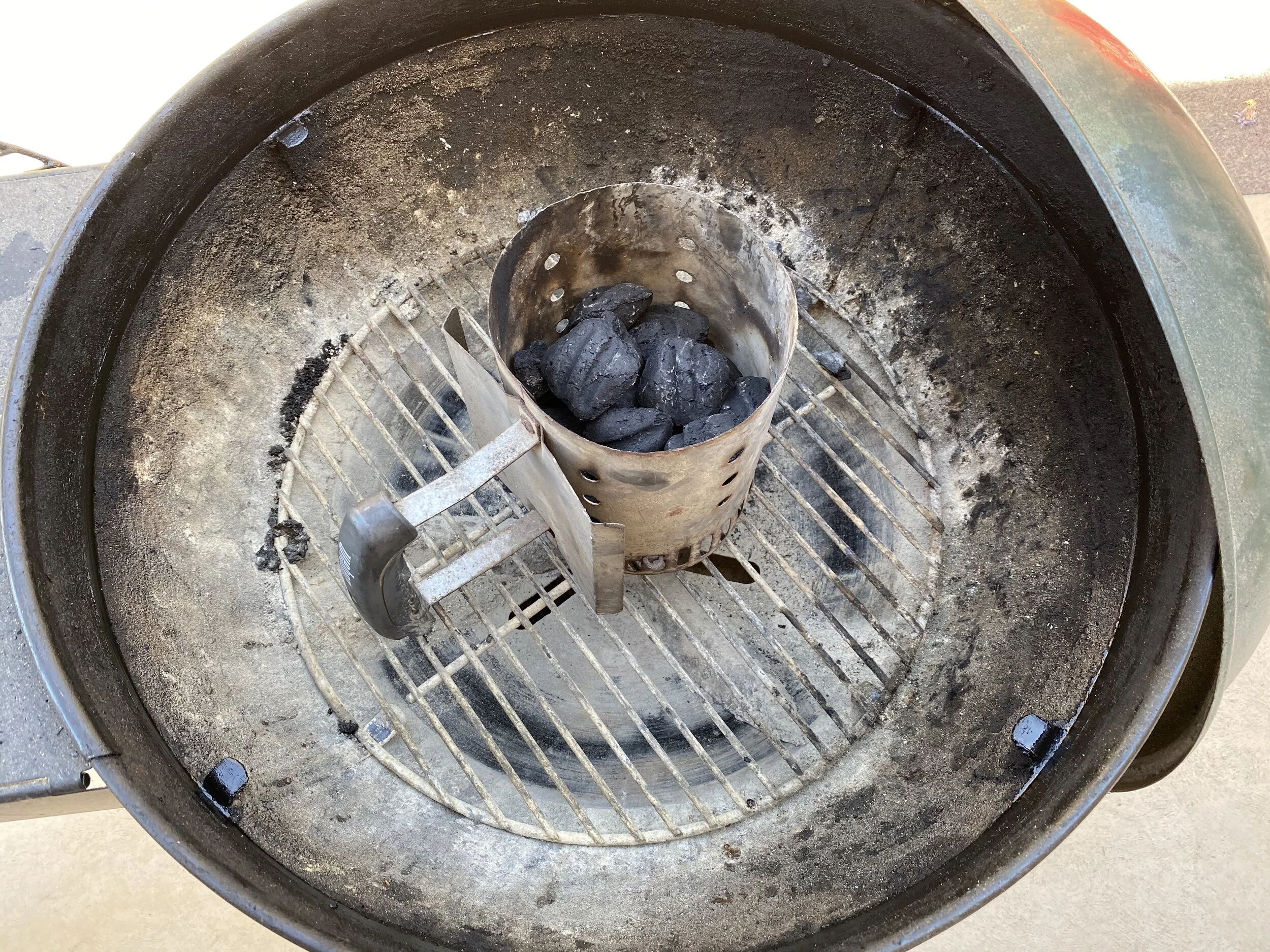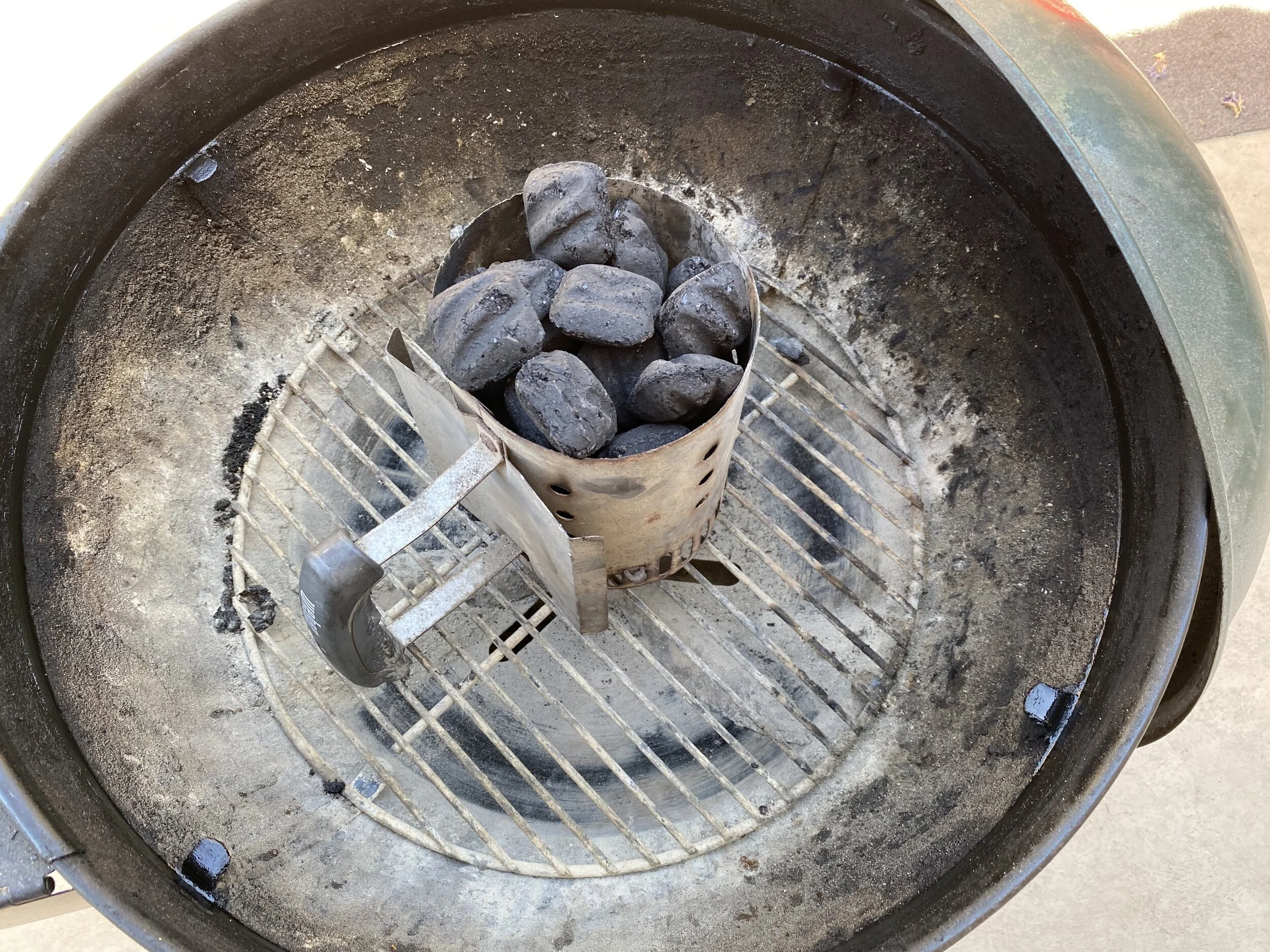Fire
So why do we use fire? First of all, what is it? It’s what you get when you combine oxygen, heat and fuel. We cook our food with it, especially outdoors. Using a charcoal and/or wood fire to cook food can add some fantastic flavors without adding any calories (If you care about such a thing). You also get an added bonus when cooking with charcoal and wood, smoke! More on that in another article. Let’s continue on and talk more about fire.
Where to begin? How about starting a fire? We’ve talked about starting our charcoal a few different ways on our podcast and site. My preferred method is using a chimney starter. I use the small one that weber makes, because for 95% of my cooking that’s all I need. You can go about lighting a chimney of coals by placing a lighter cube underneath it and lighting it. You can come back 10-15 minutes later to fully lit coals. I will reference using a chimney for the duration of this article, but there are other methods that you can translate these to, like my fellow Grill Coach Jay uses an electric ring to start his fires.
On this site, we’ll talk about different levels of fire for cooking. You’ll also see them mentioned in our recipes. A conventional stove or gas grill has dials that you can set to low, medium and high. We want to help you translate that to your grill or BBQ where you do not have a method of automatic temperature control.
You’ll find that using different levels of fire can be useful in everyday cooking. One limitation to the charcoal grill is that you can’t just turn a dial to adjust your heat. There’s simple ways to work around this though, read on and I’ll show you.
So let’s discuss what a low, medium and high fire means to me.
Low Fire
This is about 15-20 coals or about a half a small chimney starter fully lit. I use this for quick grilling of something delicate like seafood or thinly cut vegetables. You could also do a roast with a low fire. A low fire doesn’t have to be limited to the type of food you’re cooking either, if i’m not cooking a lot of food for example I will often use a low fire.
Medium Fire
This is about 30-40 coals or one small chimney starter of fully lit charcoal. I use a medium fire almost every time I fire up the grill. This is great for steaks, chicken, pork chops, sausages. I find that this is the proper amount of heat / and cook time that you need for most everyday cooks.
High Fire
This is about 80-100 coals or one large chimney full of fully lit charcoal. It’s about half a Weber full of charcoal. I don’t use this much fuel fully lit unless I'm doing some high heat searing. You can also cook using indirect heat very quickly using this method.
Weber Compact Rapid Fire Chimney Starter vs Rapid Fire Chimney Starter
Use these as a guideline only, I really don’t want anyone out there counting briquettes and stressing over how much charcoal they are using. If you do like to geek out though like me, check out my article on stretching a bag of charcoal for tips on maximizing your fire.
Once you have your fire going, you’re going to want to tune and adjust it. There are many ways you can adjust fire in a kettle too. I typically put my coals fully lit off to one side of the grill. How they are arranged can affect burn time as well as heat patterns. For example, if you spread out all your coals flat across the charcoal grate at the bottom you’ll get a hot fire for a short amount of time, compared to if you pile them up in a stack you’ll get a much longer burn time out of the coals. Why? Air flow. You restrict the airflow to the coals in the center and they will burn slowly giving you more cooking time. You get less heat, but you can use that to your advantage.
Another way you can adjust the heat is limit the air flow. I’m talking about the vents on the bottom and top. I don’t typically do this, but you can play around with the top and bottom vents to adjust airflow. I manipulate the amount of heat beforehand with the amount of coals rather than fine adjustments with the vents. I don’t do too much adjusting with the top or bottom vent once my fire is going the way I need it to. Opening and closing the lid on your cooker makes a big impact too. So for cooking in a controlled environment try to cook with the lid down. If you leave the lid off while you go inside for a few minutes to prep, that fire will be much different when you come back compared to when you left it. You can use this to your advantage too. If i’m putting a final sear on something it’s good to have a hot fire going. If you only have a medium fire that has been smoldering away, open the lid up for a few minutes. This will get the fire nice and hot for a final sear before you shut it down. I’ll often wait until I see small flames. It takes some practice to get the timing down for everything, and that’s part of the fun! It just gives you more opportunities to cook outside.
The main benefit of cooking outside with charcoal and wood that we are looking for is flavor. When we use charcoal we get char on our food from that intense Maillard reaction from a direct flame. When we cook indirectly, or not over the coals we can get the flavors from our fuels (mesquite, hickory, applewood, etc.) into what we’re cooking. This is a great way to spice things up and add an extra flavor dimension to your proteins or veggies.
I encourage everyone to hone their skills at creating the right fire for the right cook, and sincerely hope this article helps you do that.
Get out there and grill!






